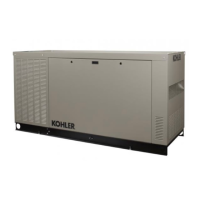TP-5393 9/93 Installation 6-3
Motor Loads
When figuring generator set capacity requirements for
installation involving motor loads, do not overlook the
high current demanded by the motor during start-up.
The“in-rush”orstartingcurrentmaybe2-5timeshigher
than that required when the motor reaches normal
operating speed. Reserve capacity must beallowed for
in-rush demandsplusotherloadswhichcouldbeonthe
line as the motor starts.
Air conditioning units are perhaps the most common
type of motor load for generator sets in recreational
vehicles. The starting characteristics of the different
makes of air conditioners vary greatly—one particular
13,500 Btu unit has, for example, lower starting
requirements than an 11,000 Btu unit of another make.
When only one unit is involved, there is usually no
starting problem, provided of course, the lighting and
appliance load is not too high when the unit is started.
The trend seems to be toward larger capacity air
conditioners and theuseof morethanone unit inlarger
vehicles.Simultaneousstartingoftwounitscanpresent
problems if the capacity is marginal. Because of the
variationinstartingcharacteristicsofthe variousmakes
of air conditioners, no definite statements are made in
this publication regarding multiple-motor starting
capabilities of the mobile generator sets covered.
Delayed starting oruse of “easy starting” devices on air
conditioner units should be considered whenever
simultaneous starting of more than one motor is
involved. The starting and running requirements of
some motor loads common to mobile applications are
listed in Figure 6-1. Use this as a guide when selecting
generator set capacity requirements involving motor
loads. See Figure 6-2 for generator set capabilities
regarding air conditioners. Capabilities will vary
according to KILOWATT DERATING following. For
specific information regarding simultaneous starting of
two or more motors, contact Kohler Co., Generator
Division—Product Applications.
Appliance Loads
Generatorsetsinrecreationalvehiclesareoftenusedto
furnish AC for appliances such as TV, stereo, electric
water heaters, etc. With the exception of theresistance
type loads such as the water heater, requirements for
appliances are usually low. Such loads must not,
however, be overlooked when figuring total
requirements. Reserve capacity shouldbe available for
anticipated appliance loads to avoid overloading of a
set.Theaveragepowerrequirementsof someelectrical
appliances toolsarelistedinFigure 6-3 andFigure 6-4.

